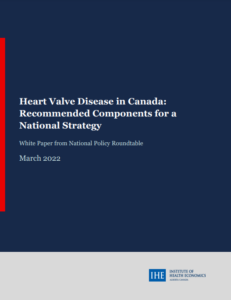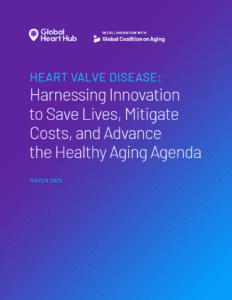Heart Valve Disease
Heart Valve Disease (HVD) occurs when one of the four heart valves cannot open properly to allow blood flow or cannot close properly to prevent the backflow of blood.1 If left untreated, HVD can cause heart failure, stroke, arrhythmia, blood clots, or death. But if detected early, a lot can be done to close the current care gap.
Heart Valve Disease Working Group

In 2022, the CCS formed a HVD Working Group that is responsible for addressing gaps in HVD care. Over the next two years, the Working Group will focus on improving detection and surveillance of patients with HVD by:
- Raising awareness and educating providers and people living with HVD;
- Advocating for system-level improvements; and
- Researching under-detection and under-treatment.
The Working Group’s priorities were informed by the IHE’s 2022 report.
Report from the Institute of Health Economics (IHE)
In 2022, the Institute of Health Economics (IHE) released a report that outlines recommendations for a national HVD strategy. Some of the key learnings from this paper include:
- HVD is the next epidemic responsible for an increasing burden on the Canadian health care system and society generally, but is treatable, if detected early.
- Patients with HVD are often underdiagnosed, undertreated, and referred for care too late.
- Awareness among people with HVD, providers, and decision-makers is needed to improve detection and care.
- Early detection is one of the greatest challenges.

New Position Paper on Heart Valve Disease and Aging
In December 2022, a roundtable of global, multi-disciplinary experts from healthcare, patient advocacy, policy organizations and the private sector gathered to discuss the challenge of HVD in the context of aging societies and their existing needs.
Based on the discussion a position paper titled ‘Heart Valve Disease: Harnessing Innovation to Save Lives, Mitigate Costs, and Advance the Healthy Aging Agenda’ was launched. The project was commissioned by the Global Heart Hub in collaboration with the Global Coalition on Aging.
Drs. Janine Eckstein and Philippe Pibarot, as well as Ellen Ross, Managing Director of Heart Valve Voice Canada, members of the CCS HVD Working Group, participated in the report.
1 Sproule J, Bond K, Warkentin L, Guo B, Zuck N. Heart Valve Disease in Canada: Recommended Components for a National Strategy. Available at: https://www.ihe.ca/publications/heart-valve-disease-in-canada-recommended-components-for-a-national-strategy. Accessed on June 17, 2022.

